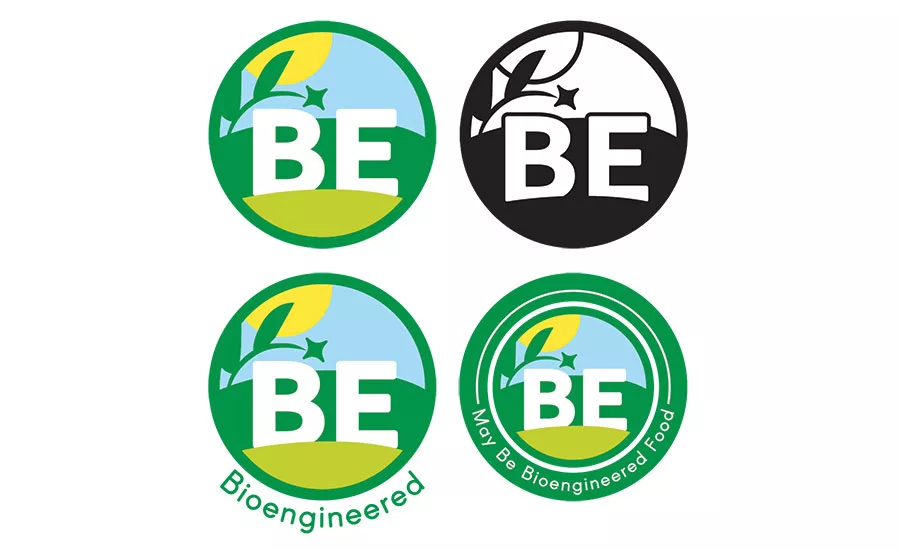Manufacturing News
New bioengineering labels are on the way
Labels will show foods are compliant with disclosure standards

USDA AMS proposed Symbol 1 (Alternative 2-A) for NBFDS shows logo only on top and with text on the bottom.
Source: USDA AMS
The USDA’s Agricultural Marketing Services has proposed three sets of symbols to be used on labels of products compliant with the National Bioengineered Food Disclosure Standard.
Proposed by the AMS, the NBFDS rule’s comment period ended on July 3, 2018. Two years ago, on July 29, 2016, Public Law 114-216 amended the Agricultural Marketing Act of 1946 by adding Subtitles E and F, which direct the Secretary to establish the NBFDS for disclosing any bioengineered (BE) food product that may be bioengineered. Subtitle E directs the Secretary to establish requirements and procedures necessary to carry out the new standard and conduct a study to identify potential technological challenges related to electronic or digital disclosure methods.
According to AMS, the term bioengineering refers to a food:
- that contains genetic material that has been modified through in-vitro recombinant deoxyribonucleic acid (rDNA) techniques; and
- for which the modification could not otherwise be obtained through conventional breeding or found in nature.
In terms of applicability, several food companies will probably have to use the “BE” logo on their label—unless they can prove there are no BE ingredients in their product. The reason is that several crops/foods use bioengineering or genetic modification, either in the food itself or an ingredient. AMS says, for example, the use of BE has been highly adopted in canola (90 percent), field corn (92 percent), soybeans (94 percent) and in 100 percent of sugar beets. AMS also lists as not-so-highly adopted (less than 85 percent)—but still subject to disclosure—non-browning apple cultivars, sweet corn, papaya, potatoes and summer varieties of squash.
Not applicable to the rule is food served in a restaurant or similar retail food establishment, very small food manufacturers, animals fed with bioengineered feed and their products, and food certified as Organic under USDA’s National Organic Program. Highly refined products without genetic traceability may be exempt. For updates and an introductory webinar on the details of what is covered and what isn’t, visit USDA’s “BE Disclosure & Labeling” website
(www.ams.usda.gov/rules-regulations/be).
BE seal of approval
According to recent consumer research from the International Food Information Council (IFIC) Foundation, nearly half of US consumers avoid GMO foods, and a large majority is primarily concerned about the human health impact. The IFIC Foundation tested reactions to three AMS BE labeling symbols and two variations of text disclosures. In every combination, levels of concern across a variety of factors increased—often substantially—when a disclosure label was applied.
When shown a bottle of canola oil without any disclosure, 31 percent of a group of respondents had human health concerns. The number rose to 50 percent when they were shown the BE “plant” symbol, further increasing to 51 percent when text was added to indicate the product was “bioengineered,” and to 57 percent when “may be bioengineered” was added to the “plant” logo.
The survey also asked about broader perceptions of GMOs. Thirty-six percent of respondents said they know little or nothing at all about BE or GMO foods, identical to the number who say they know a fair amount. Despite the low level of knowledge, 47 percent said they at least somewhat avoid GMO foods.
Looking for quick answers on food safety topics?
Try Ask FSM, our new smart AI search tool.
Ask FSM →
The vast majority (85 percent) of those who avoid GMOs do so out of concern for human health; 43 percent, environment; 36 percent, animal health; and 34 percent, agriculture/farming.
“Despite the broad consensus that GMOs are safe to consume, a majority of Americans seem to be convinced otherwise,” says Joseph Clayton, IFIC CEO. “It’s a significant disconnect, and it underscores the need for more creative public education on the science behind our food.”
When consumers were asked which combination of logo and text provided the “right amount” of information, a significant majority said that any of the three logo disclosures plus the text disclosure provided the right amount. Far fewer said the logos alone provided the right amount.
In choosing the way they’d like to receive the BE information, 51 percent chose symbol or visual on a package; 29 percent, text on a package; 7 percent, sending a text message to receive more information; 6 percent, visiting a website; 4 percent, calling a phone number; and 3 percent, scanning a QR code/link.









